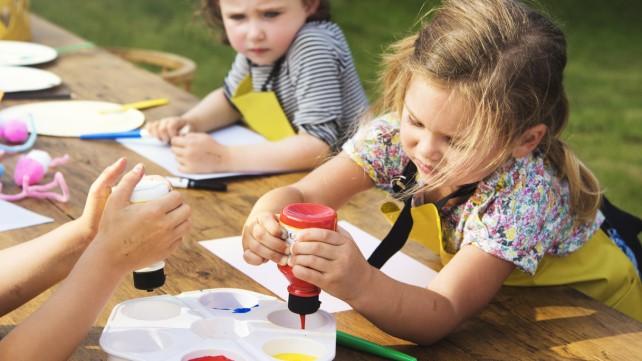Placing children at the centre of learning
Staff at Benllech Playgroup encourage children to decide how and where they would like to play and learn.

Information about the setting
The pre-school setting, Benllech Playgroup is based in the village of Benllech, in Anglesey local authority. The leaders are new to their posts since September 2021. The setting contributes to the local authority’s new curriculum piloting group to share strategies and practice.
Context and background to the effective or innovative practice
Leaders and practitioners have established a positive ethos throughout the setting. Children are thriving and flourishing in an inclusive environment, and are developing the confidence to make decisions about their play within clearly defined learning areas. Their learning is valued by practitioners. There is an open flow to the provision and children decide where they would like to play and learn.
Outdoor play is a must with the door open throughout the session. There is a wide range of resources to help children be healthy, confident and resilient individuals, from the large outside sand pit to the digging area where they can build, move, destroy and role play different scenarios.
Children are making very good progress and are developing a range of skills. For example, they can concentrate for extended periods whilst playing. Language and mathematical skills are developing naturally through their play across the stimulating environment, and through interaction with skilled practitioners. Art work has a purpose and demonstrates their own learning and development, from the splashes of paint they chose and poured independently, to the jagged cuts from their own use of scissors and stickers which they chose and carefully peeled themselves. Working in this way has fostered the children’s personal, social and emotional skills such as taking turns, self-regulation and independence, which in turn supports all other areas of learning.
Description of nature of strategy or activity
The children are resilient and lead their own play. ‘Invitations to learn’ are placed in the provision based upon information gathered from parents and the children themselves. Photos of the children with their families and pets are displayed in the setting, which supports “belonging” and encourages children to develop confidence and feel good about themselves. Staff have a friendly, warm approach and take delight in celebrating achievements. All staff recognise the children’s individual needs and are actively engaged in the children’s learning throughout. The staff wait to be invited to play alongside the children and will sit on the floor to encourage communication skills. As a result, children show good collaboration, for example when writing instructions about how to care for the cat and giving instructions verbally whilst drawing a picture. Children work together to solve problems, such as when constructing complicated builds, creating obstacle courses and playing in the role play area. Practitioners facilitate their learning by directing when required and holding back when appropriate. Children remain fully engaged and curious for long periods, for example when investigating and becoming engrossed with a bowl of keys, transporting and weighing.
What effect has this work had on provision, wellbeing and children’s standards?
The “Focus Child” strategy ensures that all children are provided with equal opportunities and that the quieter children develop confidence through supportive guidance rather than direct instructions. The livelier children are calmer and more interested as they are able to follow their interests. By making their own choices, children extend their learning at their own pace. By identifying schemas, practitioners have enabled children to express their needs in a nurturing and supportive environment. For example, where a child shows evidence of trajectory schema, staff have ensured that resources are available to satisfy the child’s needs.
Responsive planning has revolutionised the way the setting works, placing the child at the centre of the learning. Practitioners have embraced this change positively.